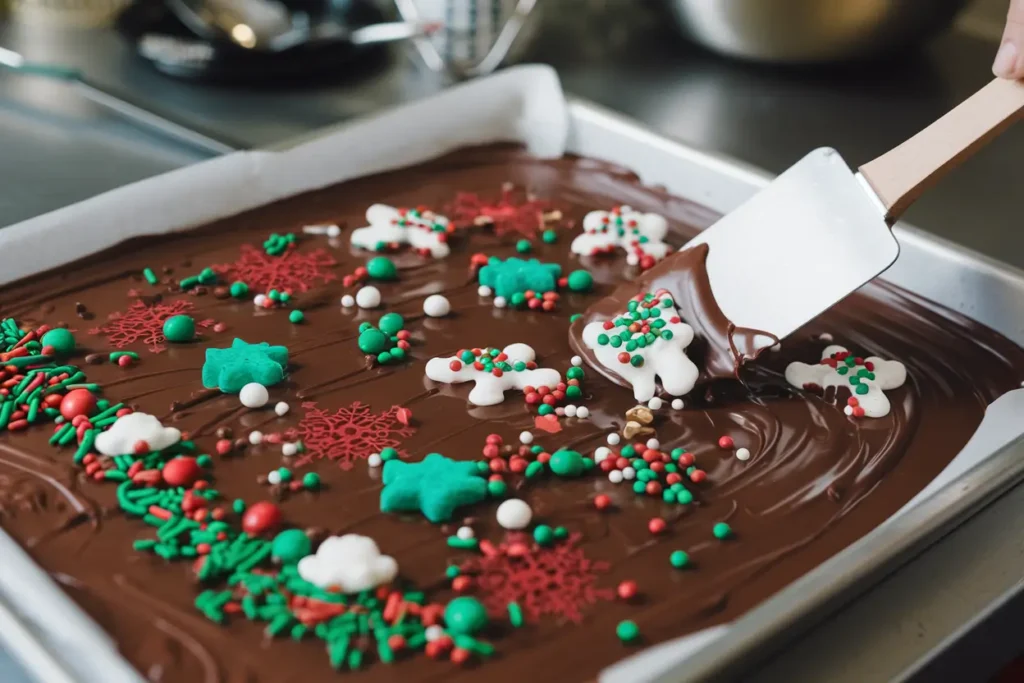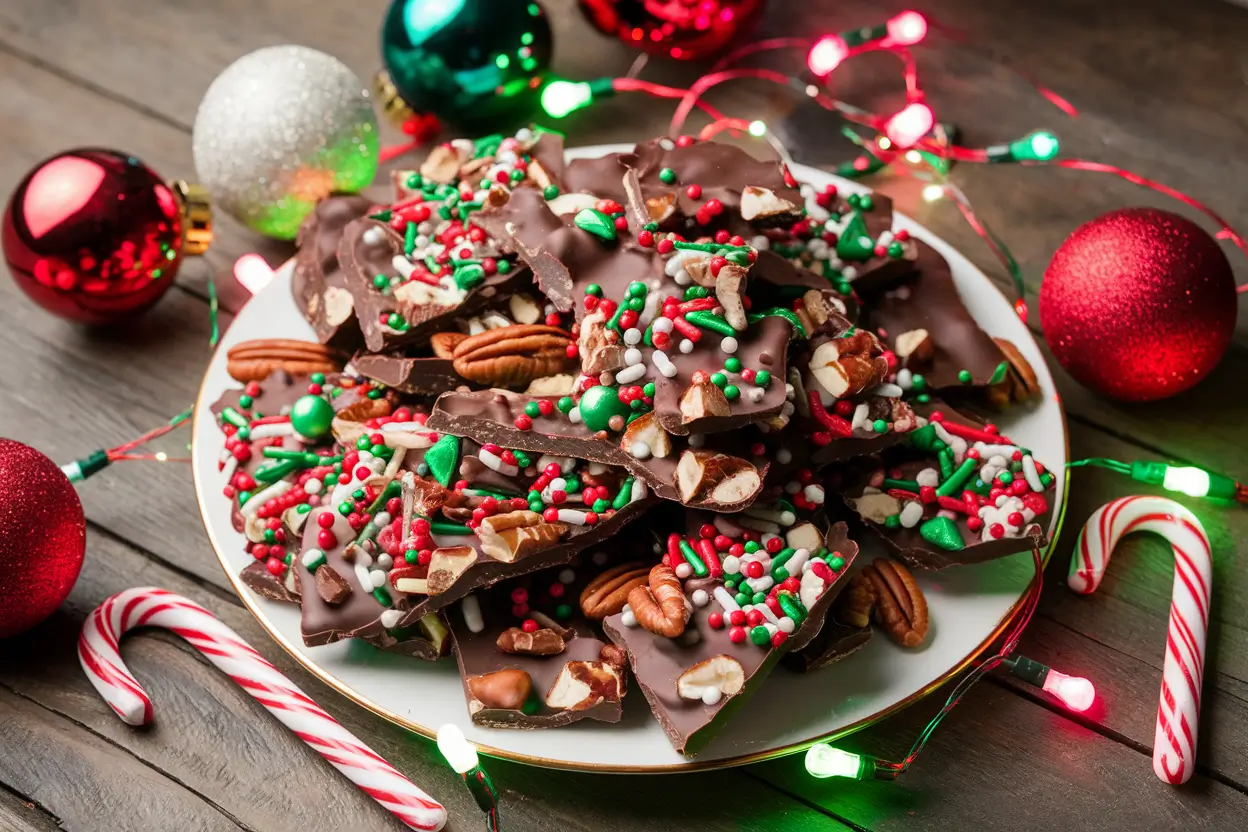Table of Contents
What Is Christmas Bark?
Christmas bark is more than just a dessert; it’s a holiday tradition that combines simplicity, creativity, and irresistible flavors. At its core, Christmas bark is a thin layer of chocolate adorned with a variety of toppings, from crunchy nuts to festive sprinkles. It’s a treat that brings smiles to faces and joy to taste buds during the festive season.
A Brief History of Christmas Bark
While its exact origins are unclear, Christmas bark likely evolved from traditional candy-making practices. Over time, this versatile dessert became a household favorite for its ease of preparation and endless customization options. It’s a holiday staple in many countries, often shared as gifts or enjoyed at family gatherings.
Why Is Christmas Bark Popular During the Holidays?
Let’s face it—the holiday season can be hectic. Christmas bark stands out because it’s quick to make, requires minimal ingredients, and can be tailored to anyone’s taste. Plus, its festive appearance makes it the perfect addition to any holiday dessert table.
“Christmas bark is like the holiday spirit in dessert form—easy to share, hard to resist, and filled with joy.”
Ingredients for the Perfect Christmas Bark
Essential Ingredients Explained
The beauty of Christmas bark lies in its simplicity. Here’s what you’ll need:
| Ingredient | Quantity | Notes |
|---|---|---|
| Dark or Milk Chocolate | 2 cups (about 12 oz) | Use high-quality chocolate for best results. |
| White Chocolate | 1 cup (6 oz) | Optional, for a layered effect. |
| Toppings | 1-2 cups | Examples: nuts, dried fruits, candy canes. |
| Butter or Coconut Oil | 1 tbsp | Helps in melting the chocolate smoothly. |
Choosing the Right Chocolate Base
Not all chocolate is created equal. For the richest flavor, opt for premium dark or milk chocolate with at least 60% cocoa. White chocolate adds a lovely contrast but is sweeter, so use it sparingly.
Toppings: From Classic to Creative
This is where you can let your creativity shine! Traditional toppings include crushed candy canes, chopped nuts, and festive sprinkles. Want to try something unique? Add pretzels for a salty crunch or dried cranberries for a tangy twist.
🎄
Step-by-Step Guide to Making Christmas Bark

Preparing Your Workspace
Before diving into the recipe, ensure your workspace is clean and organized. Lay out all ingredients and tools, such as a mixing bowl, spatula, and baking sheet lined with parchment paper.
Melting the Chocolate Perfectly
The key to smooth, glossy chocolate is gentle heating. Use a double boiler or microwave in 20-second intervals, stirring between each burst. Add a tablespoon of butter or coconut oil for extra shine and a silky texture.
Layering and Decorating the Bark
- Pour the melted chocolate onto the prepared baking sheet and spread it evenly to your desired thickness.
- If using white chocolate, drizzle it over the base and create swirls using a toothpick.
- Sprinkle your chosen toppings generously while the chocolate is still wet.
Setting and Storing the Finished Bark
Allow the bark to set completely at room temperature or place it in the refrigerator for faster results. Once hardened, break it into irregular pieces and store it in an airtight container for up to two weeks.
“Pro Tip: For a polished look, use a sharp knife to cut the bark into neat squares.”
Creative Variations of Christmas Bark
White Chocolate Peppermint Bark
This classic variation features a white chocolate base topped with crushed candy canes. It’s a minty, refreshing treat that’s perfect for the season.
Dark Chocolate Almond Bark
Rich dark chocolate paired with toasted almonds creates a sophisticated flavor profile. Add a sprinkle of sea salt to elevate the taste.
Gluten-Free and Vegan Options
For dietary restrictions, use dairy-free chocolate and gluten-free toppings like coconut flakes or dried fruits. The result is just as delicious and inclusive for everyone to enjoy.
Common Problems When Making Christmas Bark
Chocolate Not Setting Properly
If your chocolate isn’t setting, it’s likely due to humidity or an improperly tempered chocolate. Ensure your kitchen is cool and dry, and avoid overheating the chocolate.
Avoiding Chocolate Bloom
Have you ever seen white streaks or spots on chocolate? That’s bloom, caused by temperature fluctuations. To avoid this, cool your bark gradually at room temperature before refrigerating.
Balancing Flavors: Sweet vs. Salty
Too sweet? Add a pinch of sea salt or use salty toppings like pretzels. Too salty? Incorporate sweeter elements like dried fruits or marshmallows.
Tips for Making the Perfect Christmas Bark
Choosing High-Quality Ingredients
Your bark is only as good as its ingredients. Splurge on good chocolate and fresh toppings for the best results.
Timing and Temperature Matters
Work quickly when spreading the chocolate and adding toppings, as it sets fast. Keep your workspace cool to avoid premature setting.
Mastering the Art of Topping Combinations
Don’t be afraid to experiment. Mix crunchy, chewy, and creamy textures to create a more dynamic flavor experience.
Packaging and Presentation Ideas
Festive Wrapping for Gifting
Christmas bark makes an excellent gift, especially when wrapped with a touch of holiday cheer. Use clear cellophane bags tied with colorful ribbons or decorative tins adorned with festive designs. Add a handwritten tag to personalize your gift.
Storing Bark for Maximum Freshness
To ensure your Christmas bark stays fresh and delicious, store it in an airtight container. Keep it in a cool, dry place, away from direct sunlight. If you’ve included perishable toppings like fresh fruits, refrigeration is a must.
“Gifting tip: Layer your bark in a mason jar for a rustic and charming presentation.”
The Cultural Significance of Christmas Bark Recipe
How Christmas Bark Brings Families Together
Making Christmas bark isn’t just about the end product; it’s about the process. Gather your family in the kitchen, turn on some holiday music, and enjoy the shared laughter and creativity. It’s a bonding experience that creates lasting memories.
Holiday Memories Made with Bark
Whether it’s a cherished family recipe or a new tradition, Christmas bark has a way of bringing people together. It’s a reminder that the simplest things—like chocolate and a little holiday magic—can make the season extra special.
Advanced Techniques for the Perfect Bark
Tempering Chocolate for a Professional Finish
Want to take your Christmas bark to the next level? Learn the art of tempering chocolate. This technique ensures your bark has a glossy finish and a satisfying snap. Tempering may sound complicated, but with a thermometer and a bit of patience, it’s easier than you think. Melt your chocolate to 115°F (46°C), cool it down to 82°F (28°C), and reheat to 90°F (32°C) for perfection.
Incorporating Flavored Oils
Add depth to your bark by mixing in flavored oils, such as peppermint, orange, or almond. Just a few drops can transform the taste and elevate your creation.
Layering Multiple Chocolates
For a visually stunning and rich-tasting bark, create layers using dark, milk, and white chocolate. Pour each layer one at a time, allowing the previous one to set slightly before adding the next. Swirl the top layer for a marbled effect.
Creating Designer Barks
Experiment with piping techniques or use stencils to create intricate designs on your bark. Melted white chocolate in a piping bag can be used to draw festive shapes or write holiday messages.
“Think of your Christmas bark as a canvas—let your imagination run wild.”
Fun Facts About Christmas Bark Recipe
- Universal Appeal: Christmas bark recipes exist across various cultures, each with a unique twist.
- Eco-Friendly Gifting: Use recyclable packaging to make your treats more environmentally friendly.
- Kids’ Favorite: Involve your little ones in decorating—they’ll love sprinkling toppings!
FAQ: Christmas Bark Recipe
What Is Christmas Bark Made Of?
Christmas bark is made from a base of melted chocolate—typically dark, milk, or white—layered with a variety of toppings. Common toppings include crushed candy canes, nuts, dried fruits, sprinkles, and pretzels. The simplicity of the recipe makes it highly customizable, allowing you to adapt it to your preferences or dietary needs. Want a nut-free version? Stick to candy toppings or marshmallows. Prefer something healthy? Add dried cranberries or apricots for a burst of flavor.
“The beauty of Christmas bark recipe lies in its versatility. With just chocolate and toppings, the possibilities are endless!”
What Brand of Chocolate Is Best for Bark?
The quality of your chocolate can make or break your Christmas bark recipe. For a luxurious taste, opt for brands like Ghirardelli, Lindt, or Callebaut. These brands melt smoothly, ensuring a creamy texture and rich flavor. If you’re on a budget, baking chocolate from brands like Nestlé or Guittard also works well. Avoid using candy melts, as they lack the authentic chocolate flavor and may taste waxy.
Pro Tip: Always choose chocolate with a cocoa content of at least 60% for a robust flavor.
What Is the Best Way to Melt Chocolate Bark?
Melting chocolate may seem straightforward, but it’s an art that requires attention to detail. Here are two foolproof methods:
- Double Boiler: Place a heatproof bowl over a pot of simmering water, ensuring the bowl doesn’t touch the water. Stir the chocolate until fully melted.
- Microwave: Use a microwave-safe bowl and heat the chocolate in 20-second intervals, stirring after each burst. This prevents scorching.
Add a tablespoon of butter or coconut oil to make the chocolate smoother and glossier. Remember, low and slow is the key to perfectly melted chocolate.
Is Peppermint Bark an American Thing?
Yes, peppermint bark is considered an American invention. Its popularity skyrocketed in the early 2000s when brands like Williams Sonoma introduced it as a holiday specialty. The combination of white chocolate, dark chocolate, and crushed peppermint candies quickly became a festive favorite in households across the United States. While variations exist worldwide, the classic peppermint bark as we know it today has its roots firmly planted in American holiday traditions.
Conclusion
Why Christmas Bark Is the Perfect Holiday Treat
Christmas bark is more than just a dessert; it’s a symbol of holiday cheer. Its versatility, simplicity, and irresistible taste make it a must-have for every festive celebration. Whether you’re making it for yourself, gifting it to loved ones, or sharing it at a holiday party, this treat is sure to delight.
Encouragement to Experiment and Share
Don’t be afraid to put your own spin on this classic recipe. Mix and match toppings, try new flavors, and most importantly, share it with the people you love. After all, the best part of Christmas is the joy of giving—and what better gift than something homemade with care?

